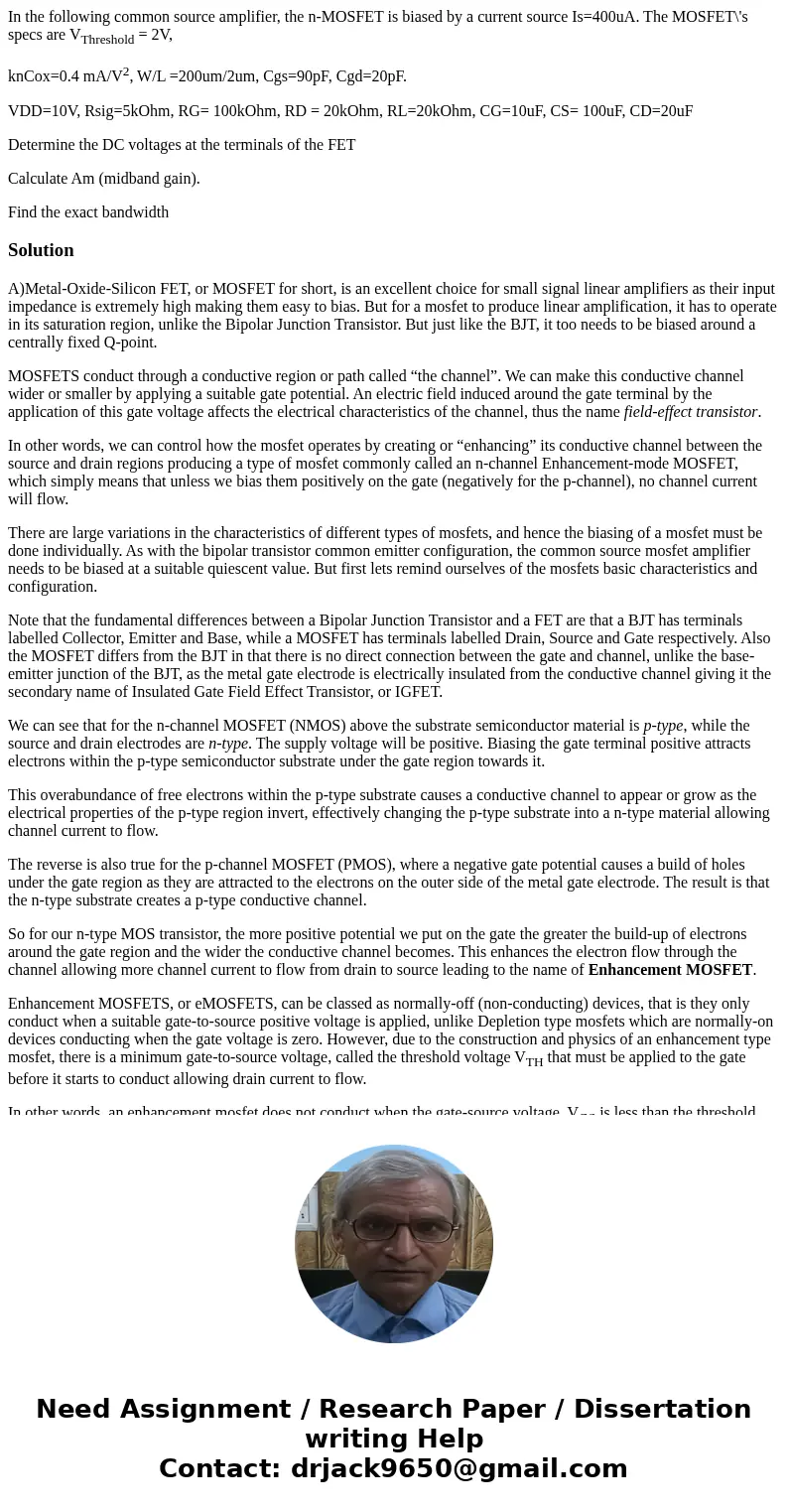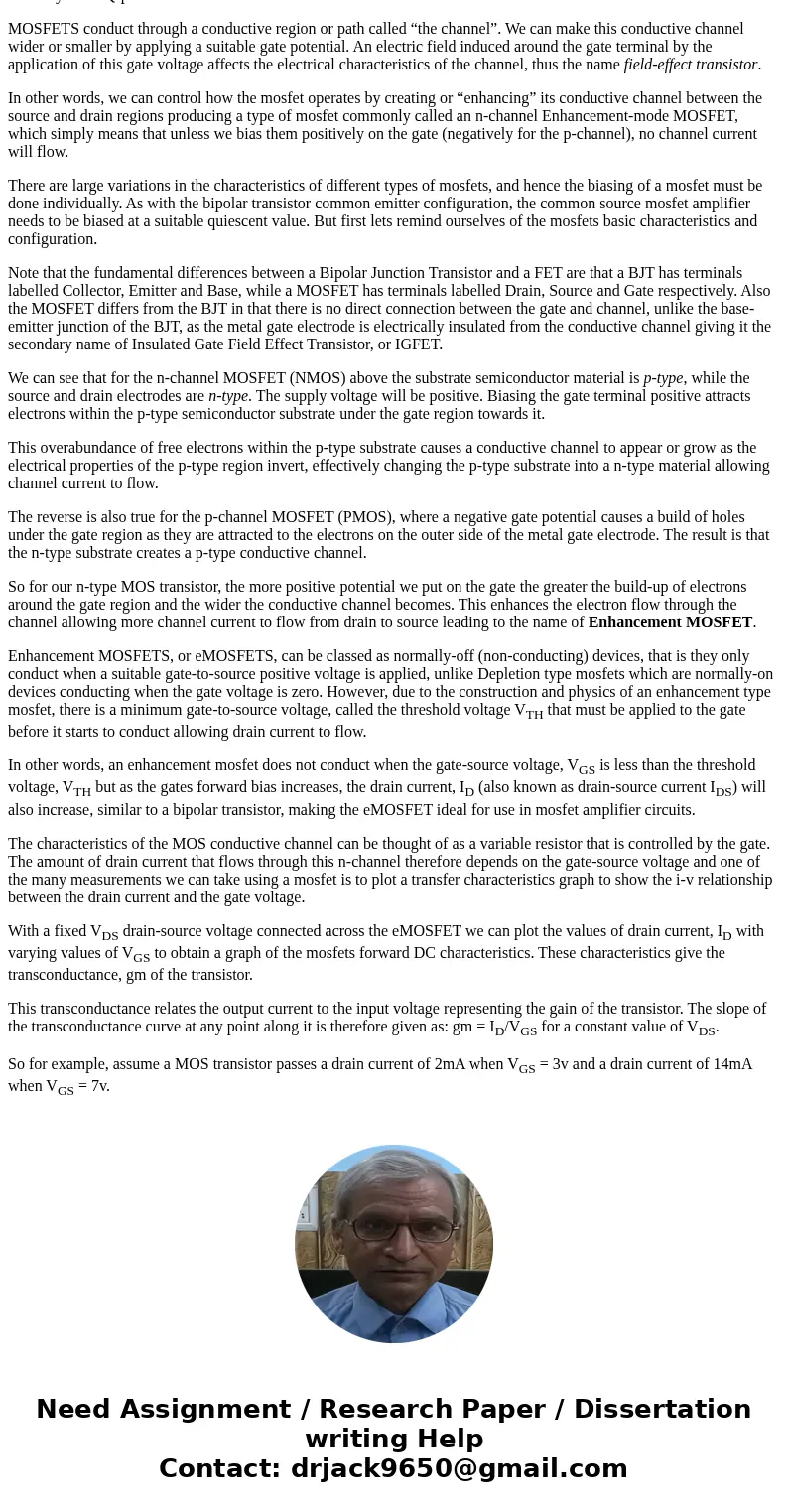In the following common source amplifier the nMOSFET is bias
In the following common source amplifier, the n-MOSFET is biased by a current source Is=400uA. The MOSFET\'s specs are VThreshold = 2V,
knCox=0.4 mA/V2, W/L =200um/2um, Cgs=90pF, Cgd=20pF.
VDD=10V, Rsig=5kOhm, RG= 100kOhm, RD = 20kOhm, RL=20kOhm, CG=10uF, CS= 100uF, CD=20uF
Determine the DC voltages at the terminals of the FET
Calculate Am (midband gain).
Find the exact bandwidth
Solution
A)Metal-Oxide-Silicon FET, or MOSFET for short, is an excellent choice for small signal linear amplifiers as their input impedance is extremely high making them easy to bias. But for a mosfet to produce linear amplification, it has to operate in its saturation region, unlike the Bipolar Junction Transistor. But just like the BJT, it too needs to be biased around a centrally fixed Q-point.
MOSFETS conduct through a conductive region or path called “the channel”. We can make this conductive channel wider or smaller by applying a suitable gate potential. An electric field induced around the gate terminal by the application of this gate voltage affects the electrical characteristics of the channel, thus the name field-effect transistor.
In other words, we can control how the mosfet operates by creating or “enhancing” its conductive channel between the source and drain regions producing a type of mosfet commonly called an n-channel Enhancement-mode MOSFET, which simply means that unless we bias them positively on the gate (negatively for the p-channel), no channel current will flow.
There are large variations in the characteristics of different types of mosfets, and hence the biasing of a mosfet must be done individually. As with the bipolar transistor common emitter configuration, the common source mosfet amplifier needs to be biased at a suitable quiescent value. But first lets remind ourselves of the mosfets basic characteristics and configuration.
Note that the fundamental differences between a Bipolar Junction Transistor and a FET are that a BJT has terminals labelled Collector, Emitter and Base, while a MOSFET has terminals labelled Drain, Source and Gate respectively. Also the MOSFET differs from the BJT in that there is no direct connection between the gate and channel, unlike the base-emitter junction of the BJT, as the metal gate electrode is electrically insulated from the conductive channel giving it the secondary name of Insulated Gate Field Effect Transistor, or IGFET.
We can see that for the n-channel MOSFET (NMOS) above the substrate semiconductor material is p-type, while the source and drain electrodes are n-type. The supply voltage will be positive. Biasing the gate terminal positive attracts electrons within the p-type semiconductor substrate under the gate region towards it.
This overabundance of free electrons within the p-type substrate causes a conductive channel to appear or grow as the electrical properties of the p-type region invert, effectively changing the p-type substrate into a n-type material allowing channel current to flow.
The reverse is also true for the p-channel MOSFET (PMOS), where a negative gate potential causes a build of holes under the gate region as they are attracted to the electrons on the outer side of the metal gate electrode. The result is that the n-type substrate creates a p-type conductive channel.
So for our n-type MOS transistor, the more positive potential we put on the gate the greater the build-up of electrons around the gate region and the wider the conductive channel becomes. This enhances the electron flow through the channel allowing more channel current to flow from drain to source leading to the name of Enhancement MOSFET.
Enhancement MOSFETS, or eMOSFETS, can be classed as normally-off (non-conducting) devices, that is they only conduct when a suitable gate-to-source positive voltage is applied, unlike Depletion type mosfets which are normally-on devices conducting when the gate voltage is zero. However, due to the construction and physics of an enhancement type mosfet, there is a minimum gate-to-source voltage, called the threshold voltage VTH that must be applied to the gate before it starts to conduct allowing drain current to flow.
In other words, an enhancement mosfet does not conduct when the gate-source voltage, VGS is less than the threshold voltage, VTH but as the gates forward bias increases, the drain current, ID (also known as drain-source current IDS) will also increase, similar to a bipolar transistor, making the eMOSFET ideal for use in mosfet amplifier circuits.
The characteristics of the MOS conductive channel can be thought of as a variable resistor that is controlled by the gate. The amount of drain current that flows through this n-channel therefore depends on the gate-source voltage and one of the many measurements we can take using a mosfet is to plot a transfer characteristics graph to show the i-v relationship between the drain current and the gate voltage.
With a fixed VDS drain-source voltage connected across the eMOSFET we can plot the values of drain current, ID with varying values of VGS to obtain a graph of the mosfets forward DC characteristics. These characteristics give the transconductance, gm of the transistor.
This transconductance relates the output current to the input voltage representing the gain of the transistor. The slope of the transconductance curve at any point along it is therefore given as: gm = ID/VGS for a constant value of VDS.
So for example, assume a MOS transistor passes a drain current of 2mA when VGS = 3v and a drain current of 14mA when VGS = 7v.


 Homework Sourse
Homework Sourse